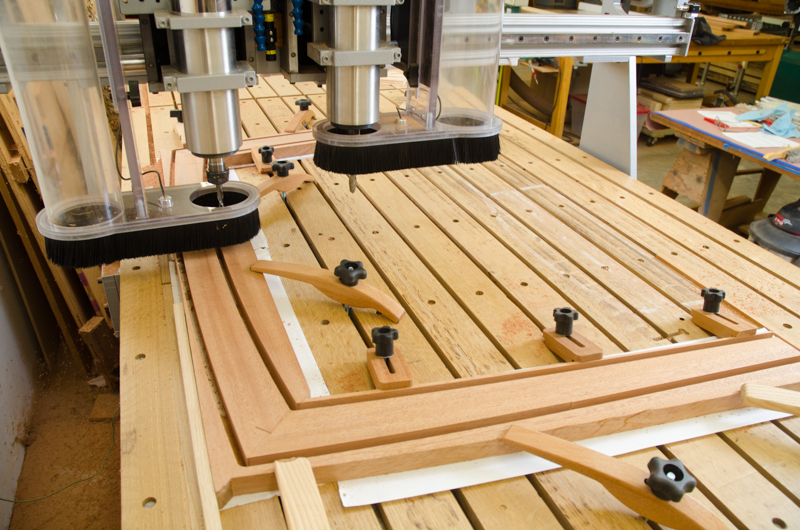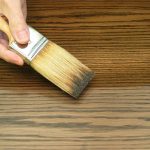We may receive a commission when you use our affiliate links. However, this does not impact our recommendations.

Using a CNC to cut and shape assembled furniture parts
These Two Can Be a Great Combination
For many years, Popular Woodworking has been an important resource for learning and an inspiration to many woodworkers – including myself. Whether it’s a new technique to learn, a skill to perfect, a tool to consider, a design to be inspired by or a plan to build, the publication has been and continues to be as important to woodworkers as any tool in the shop.
One of the great things the magazine does for its readers is to introduce them to the joys of woodworking through an emphasis on the importance of craftsmanship, developing skills with hand tools and good techniques with power tools. Expanding what we know and what we can do is how we all become skilled and passionate woodworkers.
In recent years, the magazine has taken a step beyond tools that you can touch and introduced woodworkers to a software based drawing tool: SketchUp. And, it’s along those lines that leads to what my job will be as a contributor. For readers interested in new tools and techniques I’m going to take you farther down that path and introduce you the new world of digitally based tools, show you what they can do in woodworking and explain how to use them.
Yes, we’re talking about the world of CAD (computer aided design), CAM (computer aided manufacturing) and CNCs (computer numeric control). That’s a lot of acronyms and it can be a little confusing. So, when it comes to using these tools in woodworking, I prefer to lump it all together and call it: Digital Woodworking. Digital technology and woodworking may sound like a little strange combination at first, but I’ve found that with the right approach and some new techniques these two can work together beautifully.
At first it may seem odd that computers could be considered proper tools in a woodworking workshop, but as we already know, there’s a lot of ways to do woodworking. Just as hand tools are right for some tasks and power tools are appropriate for others, digital tools can find their place in a modern woodworker’s shop. I really believe that the combination of different approaches is ultimately the artistic sweet spot for creative woodworkers to explore.
So, what does all that mean to you as a woodworker? Certainly, if you’re a dedicated hand-tool-only woodworker, Digital Woodworking may not mean as much. But, just as many hand tool craftsmen and women appreciate the benefits of a few power tools on occasion, woodworkers of all types might be curious about what can be done with new tools like CNC routers. Or Laser Cutters. Or, other exciting tools coming your way soon. Where technology and woodworking intersect will be the primary focus of my blog posts and articles for the magazine.
Other Woodworking Topics I’ll Cover
I also plan on writing about other topics, too. I’m a full time furniture maker who produces a lot of pieces in a small shop. Therefore, I have to be hyper-efficient in my work. I love finding ways to work better, quicker and more accurately. I’m constantly thinking about every single step, every movement and every technique I use and try to improve on them. I’ve found that in teaching woodworking classes, there’s a number of methods, techniques and skills that professionals use to be more efficient, more accurate and less prone to mistakes that are just as valuable to passionate woodworking hobbyists in their home shops. I’ve seen plenty of mistakes happen because some of these principals aren’t observed. I plan on sharing as many “tricks of the trade” and techniques as I can.
The final subject I’ll be covering is design. Before I got into woodworking, I had a long and successful career in design. Being a designer has been invaluable to me as a woodworker and becoming good at design should be important to you as well. Too often, there’s a key misunderstanding about what design actually is. Despite what a lot of people think, design is not an instinct based or gut feeling means of expression. It doesn’t work that way. It’s a real skill with numerous visual techniques that good designers master and use repeatedly in order to get excellent results no matter what visual problems there are to solve.
Just like woodworkers learning to hand cut dovetails, the basics of design and how to apply them can be learned. Circling back to my main topic, it just so happens that design is the trick, the hidden secret, that special sauce, when it comes to getting the very best out of Digital Woodworking. Really. The same is true for all woodworking, for that matter. Just more so when it comes to the digital world. Since good design is important I’ll share techniques and tips wherever I can.
What’s Coming Up
In upcoming posts and articles I’ll discuss how I started in woodworking and how digital technology has been an important part of my work from the beginning. I’ll talk about what I do in my shop with these digital tools. Down the road, I’ll cover hardware like CNCs, Laser Cutters and other specialized tools, computer based tools like CAD, CAM and other specialized software. I’ll explore exciting upcoming technology, interesting new projects you can make with digital and/or traditional tools, a new workbench design, custom flexible toolboxes, ways to learn this stuff and many new techniques and skills and tricks that are unique to working with wood and digital tools. Plus, a way that you can take advantage of CNCs to make your patterns even if you don’t own a machine by using outside services. There’s definitely a lot to cover.
Looking down the road, I can tell you up front that Digital Woodworking comes with many of the same woodworking problems to solve, several new skills to learn and many old and new challenges to overcome. Fair warning. This kind of woodworking will never be as simple as clicking a mouse. That’s because woodworking is quite complicated. What would be the fun in “simple”, anyway? We’re woodworkers. We like to be engaged, challenged to improve our skills and we like to build things. Going digital offers all those things, too.
Finally, I want to thank Megan, Jon and Rodney of Popular Woodworking for the opportunity to introduce the readers and fellow woodworkers to Digital Woodworking. It’s a big step for a magazine focused on woodworking to enter this new world. And, just as it was in the past when power tools first showed up in woodworker’s shops, it’s a natural step for the magazine to introduce and explore new technology, as well as support the readers along the way.
BTW: Did I mention that digital tools come with some amazing perks? Much more about that, later.
Here are some supplies and tools we find essential in our everyday work around the shop. We may receive a commission from sales referred by our links; however, we have carefully selected these products for their usefulness and quality.










Sounds quite peculiar. Would give it a try.
I can’t say that I feel enthused by this new feature. Any significant move in this direction by PWW would, from my perspective, be a bad thing. I am currently receiving renewal notices and renewal would have been automatic until I read this post. I will now wait and see. Maybe I will be pleasantly surprised, however I doubt it.
While reading what your planning, I couldn’t help but think that this could be an entire magazine all by itself. Looking forward to your contributions.
This. Sounds. Awesome.
Please keep these things coming.
I’m waiting for the time when I can 3D print or pick up a CNCed pattern from Kinkos or Target just like I used to get pictures or print out a large scale template.